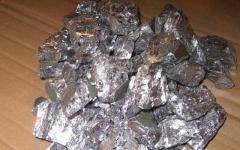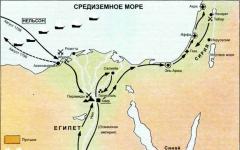In a small cozy museum of the Baltic Fleet, located in a building still built by Germans in Baltiysk (Kaliningrad region), the guide demonstrates historical relics - first from the times of Peter the Great (cannons, anchors and flags from Swedish ships), then from the times of the First and Second World Wars. And finally, he moves on to modern exhibits, with particular pride demonstrating the control panel of Project 12321 “Jeyran” air-cushion landing ships installed on the stand, most of which were based in Baltiysk: “It’s unlikely you’ll see something like this anywhere else!” “Well, why? — I note cautiously. “Just yesterday I saw how they drive the Zubr!” The guide grins with increased respect: “And how are you not deaf?”
| Small landing hovercraft (MDKVP) project 12322 "Zubr" | ||
|
Cruising range: 300 nautical miles Sailing autonomy: 5 days Crew: 27 people |
Developer: Central Marine Design Bureau "Almaz" |
Total displacement: 555 t Height (hovercraft): 21.9 m |
|
Length: 488 m Width: 74 m |
Power of gas turbine units: 5 x 10,000 hp. | Full speed: 60 knots |
| Landing capacity: 3 tanks (up to 150 tons), or 10 armored personnel carriers (up to 132 tons), or 8 infantry fighting vehicles (up to 115 tons), or 8 amphibious tanks, as well as 140 landing personnel | Armament: two MC-227 launchers for 140 mm unguided rocket projectiles (ammunition - 66 projectiles), two 30 mm automatic installations AK-630 (ammunition - 3000 shells), 8 sets of Igla MANPADS | |
landing ship The Mordovia, standing on the concrete pier of the Baltiysk military harbor, looks a bit like a beached whale. Only it does not at all reek of helplessness - the gaping mouth of the lowered “lip” of the flexible rubber fence and the front ramp are more reminiscent of a predatory smile. Several infantry fighting vehicles are lined up in front of the ship, and one of the officers is making gestures to help the driver mechanics reverse inside. After the last infantry fighting vehicle takes its place in the troop compartment, the officer carefully checks the placement of the vehicles. He doesn’t like something, and at his command several infantry fighting vehicles move forward—literally a few centimeters. Finally, the results of the check satisfy the officer, and the cars are secured with chains. The ship's commander, captain 3rd rank Sergei Konov explains the meaning of these manipulations: “Accurate alignment of the cargo is very important for a hovercraft. If the stern trim exceeds 2°, the bow rises too high above the water, the stern drops, and the pressure of the oncoming air flow may exceed the air pressure created by the cushion. There will be a danger of the flexible rubber barrier breaking while moving, which in effect is approximately equivalent to colliding with a wall.”


When the ship turns on the pumping units and rises on a cushion of air, a huge cloud of tiny water dust rises into the air, and on a clear day everything around begins to sparkle with numerous rainbows.
In a water coat
Huddled in a corner of the pilothouse (so as not to disturb anyone), I watch the preparations for going to sea. The posts report readiness, and finally the command is given to start the engines, freeing the herd of 50,000 horses. In the armored wheelhouse, the roar of the engines is fairly muffled, and I can only imagine how this incredible sound is perceived from the outside. At the same time, I understand that it won’t be possible to ride with the breeze: while moving, going on deck is prohibited, since when the engines are running, a person can simply be blown away.

"Rise!" — the ship’s commander, personally sitting at the helm, flips one of the toggle switches on the console. There are two blowing units installed on each side, the air intakes of which are closed on top by rotating blades. The click of a toggle switch turns the vanes, and the blowers begin to supply air to the pillow. Dust flies up around the Mordovia, the ship, shaken by large tremors, rises above the surface. Turning the steering wheel from side to side, Sergei Konov rocks the heavily loaded Zubr, which is slowly sliding down the concrete slope into the water. When the ship is completely on the water, an amazing sight opens up from the wheelhouse - everywhere you look, many rainbows sparkle - this light is refracted on a cloud of water dust raised by an air cushion. At full speed (and this is 60 knots!) the ship is almost invisible - only the bow and the glazing of the wheelhouse protrude from the cloud of water dust. Which, according to officers, also serves as a masking factor: water dust interferes with enemy radar signals, making detection and target designation difficult. The aluminum-magnesium alloy body is non-magnetic, and given its flight altitude (about half a meter), the Zubr is not afraid of either magnetic or contact mines.
 The ship is equipped with five gas turbine engines - two lower ones, each of which drives two injection units (on-board), and three upper ones - traction engines, rotating 5.5-meter variable pitch propellers in ring nozzles.
The ship is equipped with five gas turbine engines - two lower ones, each of which drives two injection units (on-board), and three upper ones - traction engines, rotating 5.5-meter variable pitch propellers in ring nozzles.
Commander and helmsman
Hovercraft are the only ones where the commander does not just give orders to the helmsman, but is personally at the helm. Displacement ships and ships sitting deep in the water are much more inertial and predictable. “Bison” hovers over the water without touching it, and literally reacts to gusts of wind: “The main problem that makes it difficult to control a hovercraft is its windage,” explains Sergei Konov. — The area of the side projection is more than 500 m2, so even a moderate wind makes its own corrections, not to mention the gusts that throw the ship off course. Therefore, in controlling the Zubr there is more from aviation than from navigation, instant reactions and correction for the wind.”
 The most formidable weapons of the Zubr are two launchers for 140-mm unguided rockets, which are used for fire support for landing forces. But you won’t see these launchers in the ship’s running position. The fact is that they are made retractable, and are pulled out only to launch NURS, and after the end of firing they are lowered again below deck.
The most formidable weapons of the Zubr are two launchers for 140-mm unguided rockets, which are used for fire support for landing forces. But you won’t see these launchers in the ship’s running position. The fact is that they are made retractable, and are pulled out only to launch NURS, and after the end of firing they are lowered again below deck.
Off-road ground clearance
Finally, the "Bison" approaches its destination - one of the beaches of the Baltic coast. Two sailors, using sights, inspect the landing site and report that everything is clear. The ship slows down and, raising clouds of sand and dust, falls onto the shore. "Landing!" — the commander flips the switch, switching the superchargers to landing mode: the blades of the upper air intakes are closed, air circulates inside the cushion, cooling the engines. The “Zubr” settles on the sand, lowers its bow and gangway, along which five landing infantry fighting vehicles slide down to the beach one after another. The gangplank is removed, and then climbed back onto the cushion - and into the sea. The whole operation takes a couple of minutes.
 Loaded with equipment, the Zubr moves heavily from the pier into the cold waves of the Baltic Sea. From the outside, however, it is quite difficult to understand - with apparent ease, although slowly, the ship, slightly waddling from side to side, slides into the water. But inside, in the pilothouse, this is clearly visible: the commander, with the help of alternating movements of the helm to the right and left, rocks the ship from side to side, so that it is easier to move this almost 500-ton colossus, trembling with its entire hull under the pressure of 50 thousand horsepower, with rough concrete.
Loaded with equipment, the Zubr moves heavily from the pier into the cold waves of the Baltic Sea. From the outside, however, it is quite difficult to understand - with apparent ease, although slowly, the ship, slightly waddling from side to side, slides into the water. But inside, in the pilothouse, this is clearly visible: the commander, with the help of alternating movements of the helm to the right and left, rocks the ship from side to side, so that it is easier to move this almost 500-ton colossus, trembling with its entire hull under the pressure of 50 thousand horsepower, with rough concrete.
Technically, a ship can not only go ashore, but also go much further overland or through a swamp. The flexible rubber fencing consists of two parts - a receiver and hinged, easily replaceable elements (“kerchiefs”). Thick reinforced rubber is quite resistant to various damages, and small holes do not affect driving performance. The ship can overcome obstacles up to 1.6-2 m high, and does not notice those less than a meter at all. There was a case when, during a demonstration of a night landing, one of the export models intended for Greece simply “rolled out” a GAZ-66, which was supposed to illuminate the landing site. Fortunately, no one was hurt, but the car, of course, had to be written off. Not without reason, the manufacturer claims that the Zubr is available for landing up to 70% of its total length coastline seas and oceans of the world.
Into the cargo compartment of a landing ship and swim to a military test site” - another editorial task in itself seemed very interesting! And as soon as I looked for photographs of the Bison on the Internet, the desire to pack my suitcase and set off towards adventure began to play out with particular force. With just its appearance, the Bison will attract the attention of anyone, even those who are infinitely far from technology. Well, our hearts - the hearts of convinced motorists and techies - were not only melted by this landing ship, they were heated to white heat. Let's go!
The propellers with which the Bison moves and is controlled are excellent even in static conditions. The ship is amazingly beautiful! Remember the triple central air vents in the Ferrari 550 Maranello or the current Mercedes-Benz A-Class? In my opinion, from a design point of view, there are quite a few similarities between deflectors and these screws. Yes, and with the actual one too. Both direct air.
The Bison was developed in the USSR by the Leningrad Central Marine Design Bureau "Almaz", which has extensive experience in building similar equipment. Almaz Design Bureau has been designing and producing hovercraft since 1955, and the predecessors of the Zubr were landing ships of the Skat, Omar, Kalmar and Jeyran projects. All of them are very similar to their successor, but have only two main propellers.
Construction of the first Bisons began in 1983 on Primorsky shipyard and the More shipyard, located in Crimea on the eastern coast of the Feodosia Gulf. Construction of the debut ship with the index MDK-95 was completed in 1986, and after development tests that lasted for two years, the ship entered service with the Navy.
A total of 17 similar ships were laid down, but two remained unfinished. Of the fifteen Bisons today, five have been disposed of, four are in service with the Greek Navy, four are working in the PRC Navy, and two more are on the balance sheet of the Baltic navy. Here they are - standing at the pier in the military harbor of the city of Baltiysk. MDK-50 "Evgeniy Kocheshkov" and MDK-94 "Mordovia". We load our cars onto Mordovia.
Inside "Zubr" is small world. With its own kitchen, compact but cozy cabins and a wardroom for four people command staff. All these rooms are located at the level of the middle deck, where we can easily drive cars using a folding solid ramp. A steep, almost vertical ladder leads to the captain's bridge from the middle deck. We leave the cars below, pulling them tightly to the deck with cables and carefully - crossbar by crossbar - we rise up.
The captain's cabin is impressive. Spacious, bright - it offers stunning views. In front of the commander's chair is a steering wheel and a huge control panel: the Zubr's navigation aids include two radar stations, a gyro and magnetic compass, day and night vision sights, a radio direction finder and a drift logger. The Bison was and remains a unique ship, awarded a bronze medal at the 44th Salon of Inventions and Innovations Brussels Eureka-95. Even today, it is the world's largest amphibious hovercraft.
Just think about it: displacement - 555 tons. 56 meters long, 22 meters wide and 150 tons of capacity! The Bison can carry 3 tanks or 8 infantry fighting vehicles. Or maybe ten armored personnel carriers or 140 paratroopers and 130 tons of cargo. At the same time, about 70% of the coastlines of our planet are available for disembarking people and unloading equipment for the Zubr. The ship can deliver fighters to the battlefield at a speed of 60 knots or 111 km/h!
The ship itself is armed with: two six-barreled AK-630 artillery mounts with a caliber of 30 mm; two launchers for A-22 Ogon missiles with a caliber of 140 mm; eight launchers of Strela-3 MANPADS. Agree, it inspires! But I really hope that this arsenal will never be useful except for training.
On the middle deck, where the vehicles were located, there was a roar from five gas turbine engines with a total power of 50,000 hp. incredible. And the deck moves under your feet as if you are very drunk or in the epicenter of a small earthquake. At the same time, vibrations are minimal. Climbing onto the captain's bridge, you find yourself in a different reality. Not only does it not shake at all, it is also quite quiet.
If you find a landmark on the surface of the water or on the shore, you will be literally shocked by how fast the ship is moving. According to the sailors, in eight to nine hours you can reach St. Petersburg on the Zubr. Our race to the Khmelevka military training ground lasts no longer than half an hour. Now sit down if you are standing: in this half hour the Bison consumed about 3 tons of diesel fuel. The declared consumption is 6 tons per hour! And yet it's worth it. Sailing (that’s what naval sailors call it) on this ship is one of those adventures that you remember for the rest of your life and tell to your grandchildren.
We go down from the wheelhouse to the middle deck, start the cars and roll out along the ramp onto the sandy shore of the military training ground in Baltiysk. There are other tests ahead - much more familiar and very interesting in their own way.
MDK type "Zubr"
Construction and service
General information
| 555 / T.Displacement (standard/full) |
| 157.3 / 25.6 / 21.9 m.Dimensions (length/width/draft) |
| EU Main
VP supercharger drive
Electricity supply
Mover
|
| 110 km/h/60 knot Travel speed |
| 555 km/300 milesCruising range |
Booking
Armament
Anti-aircraft missile system
- 2 × A-22 “Fire” air defense missile launchers.
Cannons
- 2 x 30mm automatic installations type AK-630.
MANPADS
- 8 sets of portable air defense systems of the Igla type or Stinger.
Radioelectronic
- general detection radar "Positive";
- navigation complex Ekran" in support of the MR-244-3 radar;
- complex of electronic warfare equipment “Slyabing”;
- communications complex "Buran".
Landing capacity
- three T-80 tanks and 100 landing troops;
- 10 armored personnel carriers or eight BMP-3s and 140 landing troops;
- 500 landing personnel with full equipment.
The hovercraft does not have anchors, its function is performed by a flexible fence, which, when not in operation, is lowered and the vessel remains motionless. The working state of the “skirt” is considered to be lifting to a height of up to 6 meters from the ground, with the help of air forced under it, which, in turn, does not go beyond its limits and creates a lifting force. When using three propulsion engines and rudders, the ship has good maneuverability.
The central command post is equipped helm aviation type. The ship is controlled by one person, officially called the pilot. From his workplace, the pilot monitors the status of propulsion and lifting engines, generators and other ship systems using five screens.
The Zubru is characterized by easy handling. The Flora-32 automated control system is responsible for the coordinated operation of all control elements, keeping the ship on course with high precision. Control of the movement of a ship and its technical means can be centralized remote, remote automated and automatic. The ship can be controlled from remote control panels when there is no one on the bridge at all.
Power plant
The engine of the Project 12322 Zubp type ships has a power of 50 thousand horsepower. The engine is an M35 power unit produced at the Zorya-Mashproekt Nikolaev enterprise. The vessel has four NO-10 injection units with a propeller, the diameter of which is 2.5 meters. Their rotation consumes all the power of the power plant. Three reversible screws are responsible for horizontal movement"Zubra". The diameter of each 4-blade propeller is 5.5 meters.
The three main gas turbine engines are located above the upper deck on pylons in special gondolas. To increase thrust, the propellers were placed in ring nozzles. At the KVP Project 1232, for example, four propellers with a diameter of 6.2 m processed power of 32,000 hp. and provided a speed of 50 knots. On the larger KVP pr. 12322, three propellers of approximately the same diameter process a power of 30,000 hp. With. and provide a stroke of 60 knots (at 15 °C) or 40 knots (at 35 °C). Unlike the prototype, the Zubr has two gas turbine engines (the same as the main gas turbine engines) that drive the air cushion supercharger. Thanks to this design, it was possible to abandon complex system transmissions.
To prevent clogging of the main gas turbine engines, air for them is taken from the supercharger receiver (as in Project 12321), and then three-stage cleaning is carried out: in the first and third stages - through small-diameter (100 mm) vortex cleaners of the “Cyclone” type, and in the second - through porous filters with coagulation of water droplets.
The maximum speed is 111 km/h, the range is 555 kilometers.
Crew and habitability
There is little information about habitability. The crew compartments are located in the bow of the vessel. The ship is equipped with a ventilation, air conditioning, heating system and soundproofing coatings. Autonomy is 5 days for the crew, 1 day for the crew and troops. The video (see the "video" section) gives an idea of the comfort level of the Zubr rank and file.
Armament
A-22 "Fire" SAM launcher

Shots for the A-22 “Fire”
140-mm multiple launch rocket system - flamethrower-incendiary complex. The system was created and produced by SNPP "Splav" (Tula) and is intended for arming river and landing ships, as well as hovercraft.
Guidance - optical sight "Shelon-14" (rangefinder-sighting device - DVU-3-BS, weight 300 kg). The rangefinder and sighting device is designed for remote control of the complex’s firing at coastal and surface targets, as well as for searching and detecting targets in daylight and dark, subject to their meteorological visibility. DVU-3-BS ensures the generation of full horizontal and vertical guidance angles and their automatic transfer to the launcher.
Launcher - MS-227, 22 barrels, stowed under deck in stowed position, manual reloading.
Dimensions (LxWxH) 2125 mm x 1735 mm x 2200 mm
Vertical guidance angle - from -10 to +65 degrees
Horizontal guidance angle - sector 320 degrees
PU weight - 1430 kg (without ammunition), 1700 kg with ammunition
Complex weight:
- without/with ammunition - 2000 kg/2600 kg
Performance characteristics of the artillery unit:
Projectile caliber - 140 mm
PU barrel caliber - 140.3 mm
Range - 800-4500 m
Projectile speed at the barrel exit - 27-40 m/s
Projectile speed at the end of the active section - 400 m/s
Maximum carrier speed when firing - up to 30 knots
Complex reaction time - 8 s
Sea roughness when shooting - up to 3 points
Operating temperature - from -40 to +50 degrees C
30mm automatic installations type AK-630
30-mm six-barreled automatic naval artillery mount, created under the leadership of V.P. Gryazev and A.G. Shipunov. In the name "6" means 6 barrels, 30 - caliber. It is a means of self-defense for ships and can be used to destroy air targets at slant ranges up to 4000 m and light enemy surface forces at distances up to 5000 m.
Fire characteristics:
Caliber: 30 mm
Cartridge: 30×165 mm
Barrel length: 54 caliber
Rate of fire: 4000-5000 rds/min
Queue length:
6 bursts of 400 shots with a break of 5 s
6 bursts of 200 shots with a 1s break
Cartridge weight: 0.83 kg
Initial projectile speed: 1030 m/s
Firing range: 4000 m
Vertical plane: −12 to +88 degrees
Maximum yaw rate: 50 deg/sec
Horizontal plane: +180 to −180 degrees
Maximum rotation speed in the horizontal plane: 70 deg/sec
Other characteristics:
Weight: 3800 kg
Ammunition supply system: belt, continuous
Combat crew: 1 person.
Ammunition: main - 2000 units, spare bunker - 1000 units. (only for AK-630M)
Igla missile system
"Igla" (GRAU index - 9K38, according to the classification of the US Defense Ministry and NATO - SA-18 Grouse(Russian: Scottish partridge)) is a Russian/Soviet man-portable anti-aircraft missile system designed to destroy low-flying air targets on oncoming and catch-up courses under conditions of exposure to false thermal interference. The complex was put into service in 1983.
Communications, detection and control
For navigation tasks and navigation safety in the entire range of speeds, the Zubr is equipped with an integrated navigation system, a GKU-2 gyro direction indicator, a KM-60-M2 magnetic compass, an RDL-3-AP100 radio Doppler drift logger, a radio direction finder, a central gyroscopic system "Baza", a navigation RS-1 radar and satellite navigation equipment.
The ship can also receive, transport mines and lay active minefields. The possibility of receiving and setting 20-80 (depending on type) minutes is provided. The Zubr is equipped with an automated radio communication complex Buran-6, which provides communication with surface ships and coastal control posts in the KB, MB and UHF bands in telephone and telegraph modes.
Landing
The Project 12322 Zubr amphibious air-cushion landing ship can take on board military equipment and personnel forward detachments of amphibious assault forces, transport them by sea, land them on an unequipped coast and support the landing force with fire.
The Zubr's landing compartment can accommodate three medium tanks of the type T-80B (T-72A , T-64B , T-62) or 10 light armored fighting vehicles ( BTR-80 , BTR-70 or BTR-60PB), or from 360 to 500 paratroopers.
In addition, the ship could transport up to 8 infantry fighting vehicles by sea BMP-1 (BMP-2) or light tanks PT-76B. There is also an option for transporting equipment and 140 paratroopers.
Export
Information on “Zubr” first appeared on international exhibition"IDEX-93" in Abu Dhabi. In 2001, the Almaz Shipbuilding Company built two Project 12322 Zubr landing ships for Navy Greece. One was separated from the Russian Navy, repaired and transferred to the Greek side. The other one was being rebuilt at the Almaz plant. The first "Zubr" arrived at the Salamis naval base on January 18, 2001, the ship was named Kefallinia and tail number “L180”. The delivery of two warships by Almaz to a NATO member state is a new step in the field of military-technical cooperation. Two more such ships were delivered under a contract to the Greek Navy in March 2001 by the Feodosia Production Association “More”, one from the Ukrainian Navy, the other built.
The Greek "Bisons" are expected to transport 140 infantrymen with uniforms and three Leopard-class tanks, or eight armored personnel carriers of the type M113, or 500 soldiers. The ship's crew is 32 people. At Zubr, the type of equipment has been slightly changed for the foreign customer.
The Greek Navy uses Zubrs much more intensively than our fleet. For this purpose, trained and highly qualified crews were placed on them. At the same time, the Greeks operate these specialized hovercraft very competently, understanding their difference from conventional displacement ships. It is known that they highly appreciated the 12322 project. Later, according to technical reasons one “Zurb” built at the Mora Production Association was returned to the Ukrainian side.
Subsequently, Greece signed another contract with Russia for the supply of the Zubr for its Navy, to replace the lost fourth ship. Its construction was carried out at the Almaz Shipbuilding Company. This “Zubr” differs from the three ships of this project available in the Greek Navy, mainly in the composition of electronic and power equipment, while the reliability of the main systems has been increased. Under this agreement, the ship was tested in the summer and fall of 2004 and was to be transferred to the Greek Navy at the end of October of this year. But for technical reasons this event did not happen as planned. In November, “Zubr” was loaded onto a special transport ship, which headed for the shores of Greece. There the ship will be handed over to the customer. Currently, negotiations are underway with Greece on the delivery of the fifth Zubr.

Greek "Zubp"
The contract between Ukraine and China for the construction and supply of MDKVP was concluded in 2009. Its volume was estimated at about $350 million. Ukraine pledged to build and transfer four ships to China. The first MDKVP built in Ukraine was handed over to the customer in April 2013.
On March 1, 2014, the second small landing hovercraft of Project 958 “Bison” (“Ukrainian” variation of Project 12322 “Zubr”) built for this country was hastily sent to China from the territory of OJSC “Feodosia Shipbuilding Company “More”” in Feodosia (Crimea). ). The landing ship was brought by tugs into the port of Feodosia, where it was loaded onto a pontoon, from where it proceeded towards the Bosphorus and further to China. It is reported that the ship “was hastily removed from Feodosia Bay to the customer in China, under the threat of possible capture or damage as a result of possible military operations.” Apparently, the second ship did not pass the entire required test program.
Composition of the series
| Name | Serial number | Inducted into the fleet | Manufacturer | Current status |
|---|---|---|---|---|
| MDK-51 | 100 | 10.10.1988 | Disposed of | |
| MDK-122 | 101 | 2.01.1990 | Primorsky Shipyard | Disposed of |
| MDK-50, from 08/17/2001 - Evgeniy Kocheshkov | 102 | 30.10.1990 | Primorsky Shipyard | Included Russian Baltic Fleet.
Renovations were carried out in 2013-2014. |
| MDK-94, from 03/12/2001 - Mordovia | 103 | 15.10.1991 | Primorsky Shipyard | Included Russian Baltic Fleet |
| Kerkyra L182 | 107 | 28.05.2001 | Primorsky Shipyard | In service, Hellenic Navy |
| Zakynthos L183 | 108 | 25.07.2004 | Primorsky Shipyard | In service, Hellenic Navy |
| MDK-118, from 12/20/2000 Kefalonia | 104 | 29.08.1994 | Primorsky Shipyard | In service, Hellenic Navy |
| MDK-119 | 105 | - | Primorsky Shipyard | Not completed |
| MDK-120 | 106 | - |
The project 12322 Zubr small landing hovercraft (MDHV) "Evgeniy Kocheshkov" was built by the Almaz Shipbuilding Company (formerly the Primorsky Shipyard) in St. Petersburg, which specializes in military and civil shipbuilding. The Baltic Fleet includes the same type MDKVP "Mordovia", which was put into operation on October 15, 1991 as "MDK-94".
The project was developed by OJSC TsMKB Almaz.
Designed to receive amphibious assault units with military equipment from an equipped or unequipped shore, transport them by sea, land on the enemy’s coast and provide fire support for landing troops. Thanks to the design features of the air cushion, it can move on the ground, avoiding small obstacles (ditches and trenches) and minefields, move through swamps and land troops deep in enemy defenses. Up to 70% of the total length of the coastline of the world's seas and oceans is available for the ship to land troops. Is the most big ship on an air cushion.
It was laid down under construction number 102 as "MDK-50". Commissioned into the Baltic Fleet on October 30, 1990. On August 17, 2001 it was renamed “Evgeniy Kocheshkov”. Had tail numbers 615 (1990), 770 (1993).
Main characteristics: Displacement 555 tons. Length 57.3 meters, width 25.6 meters, height 21.9 meters. Speed 60 knots. Cruising range 300 nautical miles. Autonomy 5 days. Crew 27 people.
Engines: 5 GGTA with a power of 10,000 hp. every.
Weapons:
Artillery: two launchers of the A-22 “Fire” system for 140.3 mm unguided rocket projectiles (ammunition - 66 projectiles for each launcher) and a fire control system.
Anti-aircraft artillery: two 30 mm automatic installations of the AK-630 type (ammunition - 3000 shells) and an MP-123-02 fire control system.
Missile weapons: 8 sets of portable air defense systems of the Igla or Stinger type.
The ship is capable of transporting: 3 main tanks with a total weight of up to 150 tons; or, as an option, 10 armored personnel carriers with a total weight of up to 131 tons and 140 landing personnel; or 8 infantry fighting vehicles with a total weight of up to 115 tons; or 8 amphibious tanks.
For the landing there are 4 rooms with 140 seats. Instead of military equipment, the premises can be equipped to accommodate an additional 366 people (about 500 people in total).
In 2013-2014, it underwent repairs, which took place at the Yantar Baltic Shipyard. As of November 28, 2013, the equipment of propellers, fuel tanks and the bottom of the MDKVP. Also, shipbuilders will have to install a new flexible fence, the so-called “skirt” of the landing ship, under which an air cushion is created.
March 11, 2014 - into the formation of landing ships of the Baltic Fleet - after completion of repairs at the Yantar Baltic Shipyard.
On October 31, 2014, as part of the delivery of the course task, which provides for single actions for their intended purpose at sea, successfully in sea ranges against surface and air targets.
According to a message dated May 6, 2015, during the delivery of a course task at sea training grounds. According to a message dated May 22, as part of a planned outing to sea for an amphibious landing on an unequipped coast. at the International Naval Show (IMMS-2015), which took place in St. Petersburg from July 1 to July 5. On August 14, in a planned preparatory tactical exercise of a group of heterogeneous forces of the Baltic Fleet for an amphibious landing on an unequipped coast. According to a message from August 20 in the military sports game “Race of Heroes” at the Khmelevka training ground of the Baltic Fleet, which starts on August 22.
Took part in the VIII International Maritime Salon (MBMC-2017), which took place from June 28 to July 2, 2017 in St. Petersburg.
July 19, 2019 in rehearsal naval parade and military sports festival, dedicated to the Day Russian Navy.







